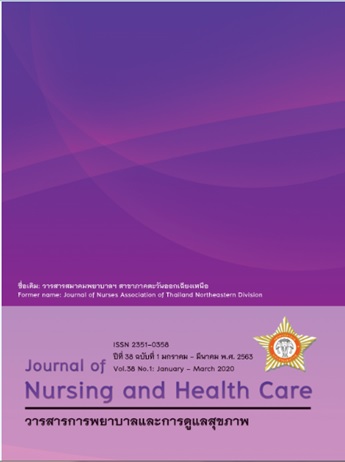Effects of Fluid Management Clinical Nursing Practice Guideline (CNPG) on Selected Outcomes in Patients with Sepsis at Emergency Department, Chum Phae Hospital
Keywords:
Fluid management, Sepsis, Clinical nursing practice guideline (CNPG)Abstract
In patients with sepsis, the management of fluids during initial hemodynamic resuscitation remains a major therapeutic challenge. However, there are several risks and conditions which may predispose to severe life-threatening. This study was aimed to evaluate the effects of fluid management in clinical nursing practice guideline (CNPG) on selected outcomes in patients with sepsis at the emergency department of Chum Phae hospital. A quasi-experimental with non-randomized control–group pretest-posttest design has been adopted for the study. A total of 60 patients with sepsis were included in this study which started from March to July 2019. The comparison group (30 cases) was treated with standard sepsis protocol treatment while the experimental group (30 cases) was treated with standard sepsis protocol treatment and fluid management CNPG. Unless otherwise stated, data are presented as mean ± SD. Statistics analyses were performed using the SPSS version 20 software package. Significant differences were assessed by independent t-test, chi-square test and relative risk (RR).
Results indicated that the comparison group patients had significant lower Mean Arterial Pressure (MAP) at hour 1 and hour 3 compared to the experimental group patients. MAP at hour 1 were 67.67 mm Hg versus (vs.) 73.07 mm Hg (SD 4.78, SD 8.58) and MAP at hour 3 were 72.20 mm Hg vs. 78.20 mm Hg (SD 4.78, SD 8.58). Comparison group patients also had significant lower serum lactate level at hour 3 and hour 6 compared to the experimental group patients. Serum lactate level at hour 3 were 3.36 mmol/L vs. 2.17 mmol/L (SD 1.31, SD .85) and serum lactate level at hour 6 were 3.39 mmol/L vs. 1.76 mmol/L (SD 1.71, SD .61). In addition, patients with fluid management CNPG had 1.58 times greater chance to increase MAP ≥ 65 mm Hg at hour 1 compared to the patients without fluid management CNPG (RR = 1.58, 95% CI 1.70–27.75). The experimental group patients had 4 times greater chance to decrease serum lactate level < 2 mmol/L (hour 3) compared to the comparison group patients (RR = 4, 95% CI 1.48–24.99). The experimental group patients had also 3.14 times greater chance to decrease serum lactate level < 2 mmol/L (hour 6) compared to the comparison group patients (RR =3.14, 95% CI 2.8–29.13). patients with fluid management CNPG had 1.58 times greater chance to increased MAP ≥ 65 mm Hg (hour 1) compared to the patients without fluid management CNPG (RR = 1.58, 95% CI 1.70–27.75). In patients with fluid management CNPG of 1.61 times has a greater chance to increase urine output ≥ 0.5 mL/kg/hr (hour 3) compared to the comparison group patients (RR = 1.61, 95% CI 2.31–161.56). Registered nurses adhered to fluid management CNPG in high level were 97.50% (SD 6.53), and they were very satisfied to use fluid management CNPG at 4.69 points. (SD 0.47).
As a result, fluid management CNPG resulted in patients safety, increased nurses adherences and increased nurses satisfaction. To confirm these effects, future studies are needed to continue fluid management CNPG to ICU or semi-ICU as recommended.
References
2. Yu B, Tian HY, Hu ZJ, Zhao C, Liu LX, Zhang Y, et al. Comparison of the effect of fluid resuscitation as guided either by lactate clearance rate or by central venous oxygen saturation in patients with sepsis. Zhonghua Wei Zhong Bing Ji Jiu Yi Xue [Internet]. 2013[cited 2019 Aug 5]; 25(10): 578-83. Available from: doi: 10.3760/cma.j.issn.2095-4352.2013.10.002.
3. Juntachum W . Statistics for nursing: Selecting the sampling and selecting sampling units. Khon Kaen; Faculty of Nursing, Khon Kaen University; 2002.
4. Kaewkungwal J, & Singhasivanon P. Sample size in Clinical research. Textbook of clinical research. Bangkok: Faculty of Tropical Medicine, Mahidol University; 2013. 107-43.
5. Qi H, Gu Q, Liu N, Zhang BY. Mean arterial pressure as an indicator of fluid responsiveness in patients with septic shock. Chin Cri Care Med [Internet]. 2013 [cited 2019 Aug 17]; 25(1): 32-5. Available from doi: 10.3760/cma.j.issn.2095-4352.2013.01.009
6. Ryoo SM, Ahn R, Lee J, Sohn CH, Seo DW, Jin H, et al. Timing of Repeated Lactate Measurement in Patients With Septic Shock at the Emergency Department. The American Journal of the Medical Sciences [Internet]. 2018 [cited 2018 Sep 25]; 356(2): 97 – 102. Available from https://doi.org/10.1016/j.amjms.2018.05.002
7. Li C, Yun D. Improvement effect of early goal-directed therapy on the prognosis in patients with septic shock. Chin Crit Care Med[Internet]. 2015.[cited 2019 Aug 20]; 27(11): 899-904. Available from DOI:10.3760/cma.j.issn.2095-4352.2015.11.007
8. Prowle JR, Chua HR, Bagshaw SM, Bellomo R. Clinical review: Volume of fluid resuscitation and the incidence of acute kidney injury - a systematic review. Critical Care [Internet], 2012[cited 2019 Aug 18]. Available from DOI: Critical Care. doi:10.1186/cc1134
9. Macedo E, Malhotra R, Bouchard J, Wynn SK, Mehta RL. Oliguria in critically ill patients Oliguria is an early predictor of higher mortality in critically ill patients. International Society of Nephrology[Internet], 2018[cited 2018 Sep 3]; 80, 760–67. Available from doi:10.1038/ki.2011.1
10. Wongnaikot P, Effects of Intrahospital Transfer Clinical Nursing Practice Guideline on Selected outcomes among Critically Ill Trauma Patients. 2017. Master of Nursing Science Thesis in Adult Nursing, Graduate School, Khon Kaen University.
11. Phunawakul S, Reungsri N, Montarak O, & Kongros J. The Development of Clinical Nursing Practice Guideline for Patients with Surgery from Traumatic Brain Injury in Phichit Hospital 2017. Department of Medical Serviced Journal[Internet]. 42(6). 102-7. Available from http://www.dms.moph.go.th/dmsweb/dmsweb_v2_2/content/org/webpageJDMS_30/demo/data/2560/2560-06/2560-06-11-10.pdf.


